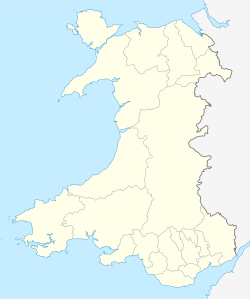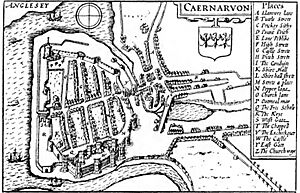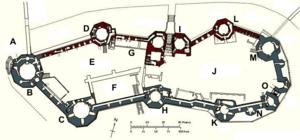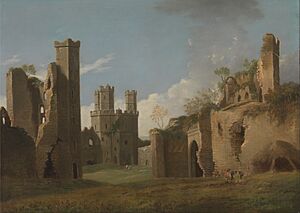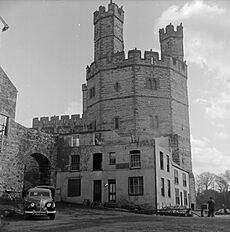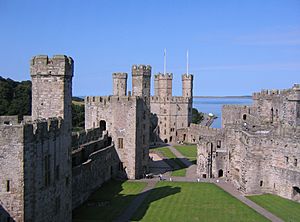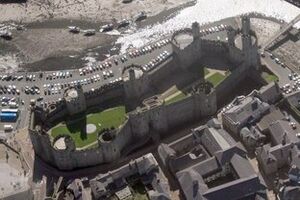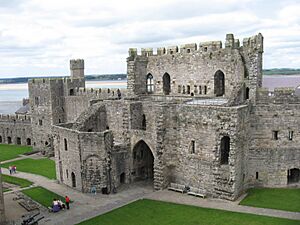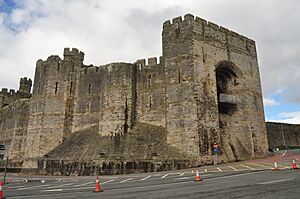Caernarfon Castle facts for kids
Quick facts for kids Caernarfon Castle |
|
|---|---|
| Castell Caernarfon | |
| Caernarfon, Gwynedd in Wales | |
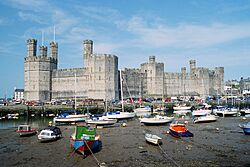
The castle from across the River Seiont
|
|
| Coordinates | 53°08′21″N 4°16′37″W / 53.1393°N 4.2769°W |
| Type | Castle |
| Site information | |
| Open to the public |
Yes |
| UNESCO World Heritage Site | |
| Part of | Castles and Town Walls of King Edward in Gwynedd |
| Criteria | Cultural: i, iii, iv |
| Inscription | 1986 (10th Session) |
|
Listed Building – Grade I
|
|
| Official name | Caernarfon Castle |
| Designated | 31 March 1983 |
| Reference no. | 3814 |
Caernarfon Castle (Welsh: Castell Caernarfon) is a huge medieval fortress in Gwynedd, north-west Wales. The first fort here was a simple motte-and-bailey castle built in the late 1000s. King Edward I of England started building the stone castle we see today in 1283.
The castle and the town of Caernarfon became an important center for north Wales. This is why the castle was built to be so grand. It was even designed to look like the ancient Walls of Constantinople. This was a way for Edward I to show his power.
While the castle was being built, strong town walls were also added around Caernarfon. Building the castle and walls cost a lot of money. Even though the outside looks finished, many parts of the castle's inside were never completed.
In 1294, the town and castle were attacked and captured by Madog ap Llywelyn. This happened during his rebellion against the English. But the English took it back the next year. The castle was also attacked during the Glyndŵr Rising (1400–1415), but it was not captured.
When the Tudor dynasty came to power in England in 1485, things became more peaceful between the Welsh and English. Castles were no longer as important for defense. Because of this, Caernarfon Castle slowly fell into disrepair.
Even though it was old and damaged, Caernarfon Castle was used during the English Civil War. It was held by the King's supporters (called Royalists). The castle was attacked three times by the Parliamentarian forces. This was the last time the castle was used in a war.
The castle was left alone until the 1800s when the government paid for repairs. Caernarfon Castle has been used for special ceremonies. The investiture of the Prince of Wales happened here in 1911 and again in 1969. Today, Cadw, the Welsh Government's historic service, looks after the castle. It is also part of a World Heritage Site called "Castles and Town Walls of King Edward in Gwynedd".
Contents
Why Caernarfon Castle Was Built
The first forts in Caernarfon were built by the Romans. Their fort, called Segontium, was just outside the modern town. It was built near the River Seiont because the spot was safe and supplies could come by river. The name Caernarfon comes from these Roman forts. In Welsh, it means 'the stronghold in the land opposite Anglesey'. We don't know much about what happened to Segontium after the Romans left Britain around 400 AD.
After the Normans conquered England, they started looking at Wales. Around 1086, a Norman named Robert of Rhuddlan was in charge of northern Wales. He was killed in 1088. His cousin, Hugh d'Avranches, built three castles to take back control. One of these was at Caernarfon.
This early castle was on a piece of land surrounded by the River Seiont and the Menai Strait. It was a motte-and-bailey castle. This means it had a large mound (motte) with a wooden tower on top. It also had a fenced area (bailey) protected by wooden fences and earth walls. The mound of this old castle was later used in the Edwardian castle. The Welsh took back Gwynedd in 1115. Caernarfon Castle then belonged to the Welsh princes. Important Welsh leaders like Llywelyn the Great sometimes stayed there.
Building the Edwardian Castle
War started again between England and Wales in 1282. The Welsh leader, Llywelyn ap Gruffudd, died that year. His brother, Dafydd ap Gruffydd, continued fighting. But in 1283, King Edward I won the war. Edward marched through northern Wales, capturing castles and building new ones like Conwy Castle. The war ended in May 1283 when Dafydd ap Gruffudd's last castle was captured.
Soon after, Edward began building castles at Harlech and Caernarfon. These castles were some of the most impressive of their time in Wales. They helped England take control. The main builder and designer of the castle was probably James of Saint George. He was a skilled architect and military engineer. He helped build many of Edward's castles in Wales.
During the castle's construction, an old story says that the body of a Roman emperor, Magnus Maximus, was found. Edward I ordered it to be reburied in a local church.
Building the new stone castle was part of a big project in Caernarfon. Town walls were added, connected to the castle. A new dock was also built. Work on the castle started around June 1283. A ditch was dug to separate the castle site from the town. A temporary fence was put up to protect the site. Wood for building came from as far away as Liverpool. Stone was taken from nearby areas like Anglesey. Hundreds of workers dug the moat and foundations. Houses were moved to make space for the castle.
King Edward I and his queen, Eleanor of Castile, visited Caernarfon in July 1283. They stayed for over a month in temporary wooden apartments.
Building continued through the winter of 1283–84. It is thought that the Eagle Tower might have been finished by Easter 1284. In March 1284, Caernarfon became a special town (a borough). It was also made the main administrative center for the area.
According to a famous story, Edward II was born at Caernarfon on April 25, 1284. He became Prince of Wales in 1301. Since then, the eldest son of the monarch has traditionally held this title. The story says the king promised the Welsh a prince born in Wales who spoke no English. Then he showed them his baby son. This story might not be true, as it only appeared much later.
By 1285, Caernarfon's town walls were mostly finished. Work on the castle continued until 1292. Building Edward I's castles in Wales cost a huge amount of money. By 1292, about £12,000 had been spent on Caernarfon's castle and town walls. The southern part of the castle was built first. The plan was to build the northern part last.
In 1294, a Welsh rebellion started, led by Madog ap Llywelyn. Caernarfon was an important English center, so the Welsh attacked it. Madog's forces captured the town in September. They badly damaged the town walls. The castle was quickly taken and burned.
In the summer of 1295, the English took back Caernarfon. By November, they started rebuilding the town. Fixing the town walls was very important. Then, they focused on finishing the castle work that had stopped in 1292. After the rebellion, Edward started building Beaumaris Castle.
Walter of Hereford took over as the main builder for Caernarfon. By 1301, another £4,500 had been spent. The focus was on the northern wall and towers. Building continued steadily until 1330.
From 1284 to 1330, between £20,000 and £25,000 was spent on Caernarfon's castle and town walls. This was an enormous amount of money. It was much more than what was spent on other famous castles like Dover Castle. Even with all this money, much of the castle was never finished. The backs of the King's Gate and Queen's Gate were left incomplete. Foundations inside the castle show where buildings would have stood.
Caernarfon Castle's Later Years
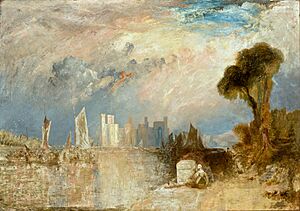
For about 200 years after Wales was conquered, the castle was always guarded. Caernarfon was like the capital of north Wales. Important jobs were usually given only to English people.
Tensions between the Welsh and English grew in the early 1400s. This led to the Glyndŵr Rising (1400–1415). During this revolt, Caernarfon was a target for Owain Glyndŵr's army. The town and castle were attacked in 1401. A battle was fought nearby in November of that year. Caernarfon was also attacked in 1403 and 1404 by Welsh and French forces.
When the Tudor dynasty came to the English throne in 1485, things changed. The Tudors were of Welsh origin. Their rule helped ease the fighting between the Welsh and English. Castles like Caernarfon became less important. They were not looked after. By 1538, many castles in Wales were "very ruined and far in decay".
At Caernarfon, the town and castle walls stayed in good shape. But things that needed care, like roofs, fell apart. By 1620, only the Eagle Tower and the King's Gate had roofs. The buildings inside the castle had been stripped of valuable things like glass and iron.
Even though the inside was ruined, the castle's defenses were still strong. During the English Civil War in the mid-1600s, the King's supporters used it. Caernarfon Castle was attacked three times during the war. The castle's commander, John Byron, 1st Baron Byron, surrendered Caernarfon to the Parliamentarian forces in 1646. This was the last time Caernarfon Castle saw fighting.
In 1660, there was an order to take down the castle and town walls. But this work was stopped early and might not have even started.
The castle was neglected until the late 1800s. From the 1870s, the government started paying for repairs. Llewellyn Turner, a castle official, oversaw the work. He often rebuilt parts of the castle, which was sometimes controversial. Steps, battlements, and roofs were fixed. Buildings that blocked the view of the castle were removed from the moat area.
Since 1908, the castle has been preserved because of its historical importance. In 1911, Caernarfon was used for the investiture of Edward, Prince of Wales. This was the eldest son of King George V. The ceremony was held there because David Lloyd George, a Welshman, insisted on it. In 1969, the same ceremony happened for Charles, Prince of Wales.
Caernarfon Castle has always belonged to the Crown. Today, it is looked after by Cadw (which means "to keep" in English). This is the Welsh Government's service for historic places. In 1986, Caernarfon became a UNESCO World Heritage Site. This shows its global importance and helps protect it. The castle also has the Royal Welch Fusiliers Museum. In 2015, a new entrance building was added.
Caernarfon Castle is now a very popular place for tourists. Over 155,000 people visited it in 2024-25. A three-year project finished in April 2023. It cost £5 million and opened up new areas of the castle. It also made the battlements accessible for wheelchairs.
Castle Design and Features
The castle's architect, Master James of Saint George, wanted the building to be very impressive. It was a symbol of England's new rule in Wales. Caernarfon was the center of government for northern Wales. The castle's shape was mostly decided by the land it was built on. It is a narrow shape, like a figure eight. It was planned to have two main areas, called "wards." The eastern ward was meant for royal living spaces, but these were never finished.
The castle walls have many towers with many sides, not round ones. These towers allowed defenders to fire along the walls. There were battlements on top of the walls and towers. The southern wall had firing galleries. These were planned for the northern wall too, but they were not built. A historian named Allen Brown said Caernarfon Castle had "one of the most formidable concentrations of fire-power" in the Middle Ages.
Most of the northern towers had four levels, including a basement. The Eagle Tower, at the western corner, was the grandest. It has three small towers on top. These once had statues of eagles. The Eagle Tower had fancy rooms. It was probably built for Sir Otton de Grandson, the first governor of Wales. A water gate in the basement allowed visitors to enter from the River Seiont. Water for the castle came from a well in the Well Tower.
Caernarfon looks different from other castles built by Edward I. It uses different colored stones in bands on the walls. Its towers are also many-sided, not round. Historians have discussed why it looks this way. Some believe the design was inspired by the Walls of Constantinople. This was a way for Edward I to show his power, linking himself to the Roman Empire. This idea might have come from a Welsh legend about a Roman emperor named Magnus Maximus. He dreamed of a beautiful fort in a city by a river in a mountainous land. Edward might have thought this dream was about Segontium. The discovery of Magnus's remains and the eagle statues on a tower might have supported this idea.
There were two main entrances to the castle. The King's Gate led from the town. The Queen's Gate allowed direct access without going through the town. Both were typical castle entrances with two towers on either side. If the King's Gate had been finished, visitors would have crossed two drawbridges. They would have passed through five doors and under six portcullises. They would also have made a sharp turn before entering the castle. This path was watched by many arrow loops and murder holes. A statue of Edward II was placed above the King's Gate, looking over the town.
The Queen's Gate is unusual because its entrance is above ground. This was because it was built into the older castle mound. Outside, a stone ramp would have led up to it, but this ramp is gone now.
The outer walls and towers are mostly still standing. But only the foundations remain of the buildings inside the castle. The royal living areas were in the upper ward. The lower ward had buildings like the kitchens. The kitchens were just west of the King's Gate. They were not strongly built. The castle also had a Great Hall. This was a large building on the south side of the lower ward. Even though only the foundations are left, it would have been impressive. It was used for royal events. If Caernarfon had been completed, it could have housed hundreds of people.
Constables of Caernarfon Castle
The Constable of the castle used to be the mayor of Caernarfon. Here are some of the Constables:
- 1890–1908: John Henry Puleston
- 1908–1945: David Lloyd George
- 1945–1963: Hon. William Ormsby-Gore
- 1963–2017: The Earl of Snowdon
- 2018–present: Edmund Seymour Bailey
Images for kids
See also
 In Spanish: Castillo de Caernarfon para niños
In Spanish: Castillo de Caernarfon para niños


